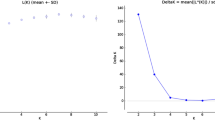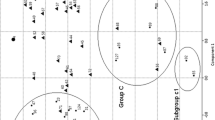Abstract
The retrotransposon-based sequence-specific amplification polymorphism (SSAP) marker system was used to assess the genetic diversities of collections of tomato and pepper industrial lines. The utility of SSAP markers was compared to that of amplified fragment length polymorphism (AFLP) and simple sequence repeat (SSR) markers. On the basis of our results, SSAP is most informative of the three systems for studying genetic diversity in tomato and pepper, with a significant correlation of genetic relationships between different SSAP datasets and between SSAP, AFLP and SSR markers. SSAP showed about four- to ninefold more diversity than AFLP and had the highest number of polymorphic bands per assay ratio and the highest marker index. For tomato, SSAP is more suitable for inferring overall genetic variation and relationships, while SSR has the ability to detect specific genetic relationships. All three marker results for pepper showed general agreement with pepper types. Additionally, retrotransposon sequences isolated from one species can be used in related Solanaceae genera. These results suggest that different marker systems are suited for studying genetic diversity in different contexts depending on the group studied, where discordance between different marker systems can be very informative for understanding genetic relationships within the study group.



Similar content being viewed by others
References
Alvarez AE, van de Wiel CCM, Smulders MJM, Vosman B (2001) Use of microsatellites to evaluate genetic diversity and species relationships in the genus Lycopersicon. Theor Appl Genet 103:1283–1292
Anderson JA, Churchill GA, Autrique JE, Tanksley SD, Sorrells ME (1993) Optimizing parental selection for genetic linkage maps. Genome 36:181–186
Araujo, PG, JM Casacuberta, APP Costa, RY Hashimoto, MA Grandbastien, Van Sluys MA (2001) Retrolyc1 subfamilies defined by different U3 LTR regulatory regions in the Lycopersicon genus. Mol Genet Genomics 266:35–41
Beer SC, Goffreda J, Philips TD, Murphy JP, Sorrells ME (1994) Assessment of genetic variation in Avena sterilis using morphological traits, isozymes, and RFLPs. Crop Sci 33:1386–1393
Bernatzky R, Tanksley SD (1986) Genetics of actin regulated sequences in tomato. Theor Appl Genet 72:314–321
Budiman MA, Mao L, Wood TC, Wing RA (2000) A deep-coverage tomato BAC library and prospects toward development of an STC framework for genome sequencing. Genome Res 10:129–136
Burstin J, Charcosset A (1997) Relationship between phenotypic and marker distances: theoretical and experimental investigations. Heredity 79:477–483
Costa APP, Scortecci KC, Hashimoto RY, Araujo PG, Grandbastien MA, van Sluys MA (1999) Retrolyc1-1, a member of the Tnt1 retrotransposon super family in the Lycopersicon peruvianum genome. Genetica 107:65–72
Daraselia ND, Tarchevskaya S, Narita JO (1996) The promoter for tomato 3-hydroxy-3-methylglutaryl coenzyme A reductase gene 2 has unusual regulatory elements that direct high-level expression. Plant Physiol 112:727–733
Dillman C, Bar-Hen A, Guerin D, Charcosset A, Murigneux A (1997) Comparison of RFLP and morphological distances between maize Zea mays L. inbred lines. Consequences for germplasm protection purposes. Theor Appl Genet 95:92–102
dos Santos JB, Nienhuis J, Skroch P, Tivang J, Slocum MK (1994) Comparison of RAPD and RFLP genetic markers in determining genetic similarity among Brassica oleracea L. genotypes. Theor Appl Genet 87:909–915
Ellis THN, Poyser SJ, Knox MR, Vershinin AV, Ambrose MJ (1998) Polymorphism of insertion sites of Ty1-copia class retrotransposons and its use for linkage and diversity analysis in pea. Mol Gen Genet 260:9–19
Fisher MC, Koenig GL, White TJ, Taylor JW (2002) Molecular and phenotypic description of Coccidioides posadasii sp. nov., previously recognised as the non-California population of Coccidioides immitis. Mycologia 94:73–84
Flavell AJ, Bolshakov VN, Booth A, Jing R, Russell J, Ellis THH, Isaac P (2003) A microarray-based high throughput molecular marker genotyping method—the Tagged Microrray (TAM) marker approach. Nucleic Acids Res 31:e115
Ford MJ (2002) Applications of selective neutrality tests to molecular ecology. Mol Ecol 11:1245–1262
Giancola S, Marcucci Poltri S, Lacaze P, Hopp HE (2002) Feasibility of integration of molecular markers and morphological descriptors in a real case study of a plant variety protection system for soybean. Euphytica 127:95–113
Grandbastien M-A, Spielmann A, Caboche M (1989) Tnt1, a mobile retroviral-like transposable element of tobacco isolated via plant cell genetics. Nature 337:376–380
Grandillo S, Ku HM, Tanksley SD (1999) Identifying the loci responsible for natural variation in fruit size and shape in tomato. Theor Appl Genet 99:978–987
Gribbon BM, Pearce SR, Kalendar R, Schulman AH, Paulin L, Jack P, Kumar A, Flavell AJ (1999) Phylogeny and transpositional activity of Ty1-copia group retrotransposons in cereal genomes. Mol Gen Genet 261:883–891
Kimura M, Crow JF (1964) The number of alleles that can be maintained in a finite population. Genetics 49:725–738
van der Knaap E, Lippman ZB, Tanksley SD (2002) Extremely elongated tomato fruit controlled by four quantitative trait loci with epistatic interactions. Theor Appl Genet 104:241–247
Kumar A, Bennetzen JL (1999) Plant retrotransposons. Annu Rev Genet 133:479–532
Lefebvre V (2005) Molecular markers for genetics, breeding: development and use in pepper (Capsicum spp.). In: Lörz H, Wenzel G (eds) Biotechnology in agriculture and forestry, vol 55. Molecular marker systems in plant breeding and crop improvement. Springer, Berlin Heidelberg New York, pp 189–214
Lefebvre V, Palloix A, Rives M (1993) Nuclear RFLP between pepper cultivars. Euphytica 71:189–199
Lefebvre V, Goffinet B, Chauvet JC, Caromel B, Signoret P, Brand R, Palloix A (2001) Evaluation of genetic distances between pepper inbred lines for cultivar protection purposes: comparison of AFLP, RAPD and phenotypic data. Theor Appl Genet 102:741–750
Leigh F, Kalendar R, Lea V, Lee D, Donini P, Schulman AH (2003) Comparison of the utility of barley retrotransposon families for genetic analysis by molecular marker techniques. Mol Genet Genomics 269:464–474
Liedloff A (1999) Mantel nonparametric test calculator, version 2.0. Queensland University of Technology, Brisbane
Lu J, Knox MR, Ambrose MJ, Brown JKM, Ellis THN (1996) Comparative analysis of genetic diversity in pea accessed by RFLP- and PCR-based methods. Theor Appl Genet 93:1103–1111
Manly BFJ (1985) The statistics of natural selection. Chapman and Hall, London
Melayah D, Bonnivard E, Chalhoub B, Audeon C, Grandbastien M-A (2001) The mobility of the tobacco retrotransposon correlates with its transcriptional activation by fungal factors. Plant J 28:159–168
Nagaoka T, Ogihara Y (1997) Applicability of inter-simple sequence repeat polymorphisms in wheat for use as DNA markers in comparison to RFLP and RAPD markers. Theor Appl Genet 94:597–602
Nei M (1973) Analysis of gene diversity in subdivided populations. Proc Natl Acad Sci USA 70:3321–3323
Olufowote JO, Xu Y, Chen X, Park WD, Beachell HM, Dilday RH, Goto M, McCouch SR (1997) Comparative evaluation of within-cultivar variation of rice (Oryza sativa L.) using microsatellite and RFLP markers. Genome 40:370–378
Paran I, Aftergoot E, Shifriss C (1998) Variation in Capsicum annuum revealed by RAPD and AFLP markers. Euphytica 99:167–173
Pearce SR, Stuart-Rogers C, Knox MR, Kumar A, Ellis THN, Flavell AJ (1999) Rapid isolation of plant Ty1-copia group retrotransposon LTR sequences for molecular marker studies. Plant J 19:711–717
Pearce SR, Knox M, Ellis THN, Flavell AJ, Kumar A (2000) Pea Ty1-copia group retrotransposons: transpositional activity and use as markers to study genetic diversity in Pisum. Mol Gen Genet 263:898–907
Pejic I, Ajmone-Marsan P, Morgante M, Kozumplick V, Castiglioni P, Taramino G, Motto M (1998) Comparative analysis of genetic similarity among maize inbred lines detected by RFLPs, RAPDs, SSRs and AFLPs. Theor Appl Genet 97:1248–1255
Porceddu A, Albertini E, Barcaccia G, Marconi G, Bertoli FB, Veronesi F (2002) Development of SSAP markers based on an LTR-like sequence from Medicago sativa L. Mol Genet Genomics 267:107–114
Powell W, Morgante M, Andre C, Hanafey M, Vogel J, Tingey S, Rafalski A (1996) The utility of RFLP, RAPD, AFLP and SSR (microsatellite) markers for germplasm analysis. Mol Breed 2:225–238
Rogers SA, Pauls KP (2000) Ty1-copia-like retrotransposons of tomato (Lycopersicon esculentum Mill.). Genome 43:887–894
Rozas J, Sánchez-DelBarrio JC, Messeguer X, Rozas R (2003) DNASP, DNA polymorphism analyses by the coalescent and other methods. Bioinformatics 19:2496–2497
Rus-Kortekaas W, Smulders MJM, Arens P, Vosman B (1994) Direct comparison of levels of genetic variation in tomato detected by a GACA-containing microsatellite probe and by random amplified polymorphic DNA. Genome 37:375–381
Russell JR, Fuller JD, Macaulay M, Hatz BG, Jahoor A, Powell W, Waugh R (1997) Direct comparison of levels of genetic variation among barley accessions detected by RFLPs, AFLPs, SSRs and RAPDs. Theor Appl Genet 95:714–722
Saitou N, Nei M (1987) The Neighbor Joining method: a new method for reconstructing phylogenetic trees. Mol Biol Evol 4:406–425
Schulman AH, Flavell AJ, Ellis THN (2004) The application of LTR retrotransposons as molecular markers in plants. In: Miller WJ, Capy P (eds) Mobile genetic elements protocols and genomic applications. Humana Press, Totawa, pp 145–174
Swofford DL (2002) paup* 4.0 beta 10. Phylogenetic analysis using parsimony (and other methods). Sinauer Assoc, Sunderland
Tajima F (1989) Statistical method for testing the neutral mutation hypothesis by DNA polymorphism. Genetics 123:585–595
Thormann CE, Ferreira ME, Camargo LEA, Tivang JG, Osborn TC (1994) Comparison of RFLP and RAPD markers to estimate genetic relationships within and among cruciferous species. Theor Appl Genet 85:976–984
Van Eck HJ, Rouppe van der Voort J, Draaistra J, Van Zandvoort P, Enckevort E, Segers B, Peleman J, Jacobsen E, Helder J, Bakker J (1995) The inheritance and chromosomal localization of AFLP markers in a non-inbred potato offspring. Mol Breed 1:397–410
Vos P, Hogers R, Bleeker M, Reijans M, van der Lee T, Hornes M, Frijters A, Pot J, Peleman J, Kuiper M, Zabeau M (1995) AFLP: a new technique for DNA fingerprinting. Nucleic Acids Res 23:4407–4414
Waugh R, McLean K, Flavell AJ, Pearce SR, Kumar A, Thomas BBT, Powell W (1997) Genetic distribution of Bare-1-like retrotransposable elements in the barley genome revealed by sequence specific amplification polymorphisms (SSAP). Mol Gen Genet 253:687–694
Weir BS (1979) Inferences about linkage disequilibrium. Biometrics 35:235–254
Weir BS (1996) Genetic data analysis II. Sinauer Assoc, Sunderland
Wright S (1978) Evolution and the genetics of populations, vol 4. Variability within and among natural populations. University of Chicago Press, Chicago
Yang GP, Saghai Maroof MA, Xu CG, Zhang Q, Biyashev RM (1994) Comparative analysis of microsatellite DNA polymorphism in landraces and cultivars of rice. Mol Gen Genet 245:187–194
Yeh FC, Boyle TJB (1997) Population genetic analysis of co-dominant and dominant markers and quantitative traits. Belg J Bot 129:157
Yu GX, Wise RP (2000) An anchored AFLP- and retrotransposon-based map of diploid Avena. Genome 43:736–749
Acknowledgements
We wish to thank Q.H. Le, A. Charcosset, M. Tenaillon, V. Lefebvre, D. Higuet and E. Bonnivard for their useful comments and suggestions. This work was funded by the FW6 EC TEGERM project EC-QLRT-1999-31502.
Author information
Authors and Affiliations
Corresponding author
Additional information
Communicated by I. Paran
Rights and permissions
About this article
Cite this article
Tam, S.M., Mhiri, C., Vogelaar, A. et al. Comparative analyses of genetic diversities within tomato and pepper collections detected by retrotransposon-based SSAP, AFLP and SSR. Theor Appl Genet 110, 819–831 (2005). https://doi.org/10.1007/s00122-004-1837-z
Received:
Accepted:
Published:
Issue Date:
DOI: https://doi.org/10.1007/s00122-004-1837-z




